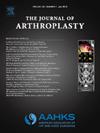Preoperative Abnormal Posture Improves After Total Knee Arthroplasty: Knee–Hip–Spine Syndrome
IF 3.4
2区 医学
Q1 ORTHOPEDICS
引用次数: 0
Abstract
Background
Spinal, pelvic, and lower extremity alignment is crucial for maintaining a healthy body posture. However, with aging, this posture becomes challenging to maintain due to muscle weakness and skeletal degeneration. Osteoarthritis (OA) of the hip and knee can also lead to abnormal posture, known as hip-spine and knee-spine syndrome. Total knee arthroplasty (TKA) can help relieve pain and improve lower extremity alignment. This may also improve abnormal posture, such as in knee–hip–spine syndrome. However, the condition of the contralateral knee may affect this improvement. This study evaluated the effects of TKA on clinical outcomes and radiographic body posture.
Methods
Patients scheduled for primary one-sided TKA were divided into 2 groups: the unilateral group comprised patients who had contralateral knee OA conditions. The bilateral group included patients who had prior contralateral TKA. Knee range of motion, the Knee Injury and Osteoarthritis Outcome Score, radiographic lateral femorotibial angle, hip and knee flexion angles, and sagittal vertical axis while standing were measured 24 months after TKA.
Results
Both groups showed improved knee extension, the Knee Injury and Osteoarthritis Outcome Score, and radiographical femorotibial angle and hip and knee flexion angles 24 months after TKA. The sagittal vertical axis also improved 6 months after TKA in both groups and was maintained in the bilateral group, while it deteriorated again in the unilateral group 24 months after TKA.
Conclusions
A TKA can improve abnormal body posture due to knee OA as in knee–hip–spine syndrome. However, the condition of a contralateral knee can affect TKA outcomes.
Level of Evidence
Level III; prospective case-control study.
全膝关节置换术后术前异常姿势得到改善:膝-髋-脊柱综合征。
背景:脊柱、骨盆和下肢对齐对于保持健康的身体姿势至关重要。然而,随着年龄的增长,由于肌肉无力和骨骼退化,保持这种姿势变得十分困难。髋关节和膝关节骨性关节炎(OA)也会导致姿势异常,即所谓的髋关节-脊柱和膝关节-脊柱综合征。全膝关节置换术(TKA)可以帮助缓解疼痛,改善下肢排列。这也可以改善异常姿势,如膝-髋-脊椎综合症。然而,对侧膝关节的状况可能会影响这种改善。本研究评估了 TKA 对临床疗效和影像学身体姿势的影响:方法:将计划接受原发性单侧 TKA 的患者分为两组:单侧组包括患有对侧膝关节 OA 的患者。双侧组包括曾接受过对侧 TKA 的患者。在TKA术后24个月测量膝关节活动范围(ROM)、膝关节损伤和骨关节炎结果评分(KOOS)、影像学侧股胫角(FTA)、髋关节和膝关节屈曲角以及站立时的矢状纵轴(SVA):结果:两组患者在 TKA 术后 24 个月后的膝关节伸展、KOOS、放射学 FTA、髋关节和膝关节屈曲角度均有所改善。两组患者的 SVA 在 TKA 术后 6 个月均有所改善,双侧组患者的 SVA 保持不变,而单侧组患者的 SVA 在 TKA 术后 24 个月再次恶化:结论:TKA 可以改善膝关节 OA 引起的身体姿势异常,如膝-髋-脊椎综合征。结论:TKA 可以改善膝关节 OA(如膝-髋-脊柱综合征)导致的身体姿势异常,但对侧膝关节的状况会影响 TKA 的效果。
本文章由计算机程序翻译,如有差异,请以英文原文为准。
求助全文
约1分钟内获得全文
求助全文
来源期刊

Journal of Arthroplasty
医学-整形外科
CiteScore
7.00
自引率
20.00%
发文量
734
审稿时长
48 days
期刊介绍:
The Journal of Arthroplasty brings together the clinical and scientific foundations for joint replacement. This peer-reviewed journal publishes original research and manuscripts of the highest quality from all areas relating to joint replacement or the treatment of its complications, including those dealing with clinical series and experience, prosthetic design, biomechanics, biomaterials, metallurgy, biologic response to arthroplasty materials in vivo and in vitro.
 求助内容:
求助内容: 应助结果提醒方式:
应助结果提醒方式:


